Setting up the Tarantula enclosure requires minute considerations related to its substrate, temperature, and humidity levels so that these stunning arachnids find solace in their living. Tarantulas are fascinating creatures that have captured the interest of many as exotic pet keepers. The terrarium of tarantula should mimic the natural environment in captivity to keep your eight-legged companion happy.
Keeping a tarantula as a pet requires careful consideration of their habitat, thriving conditions, climatic changes, and many more. One of the critical aspects of tarantula care is providing an appropriate enclosure and its orientation.
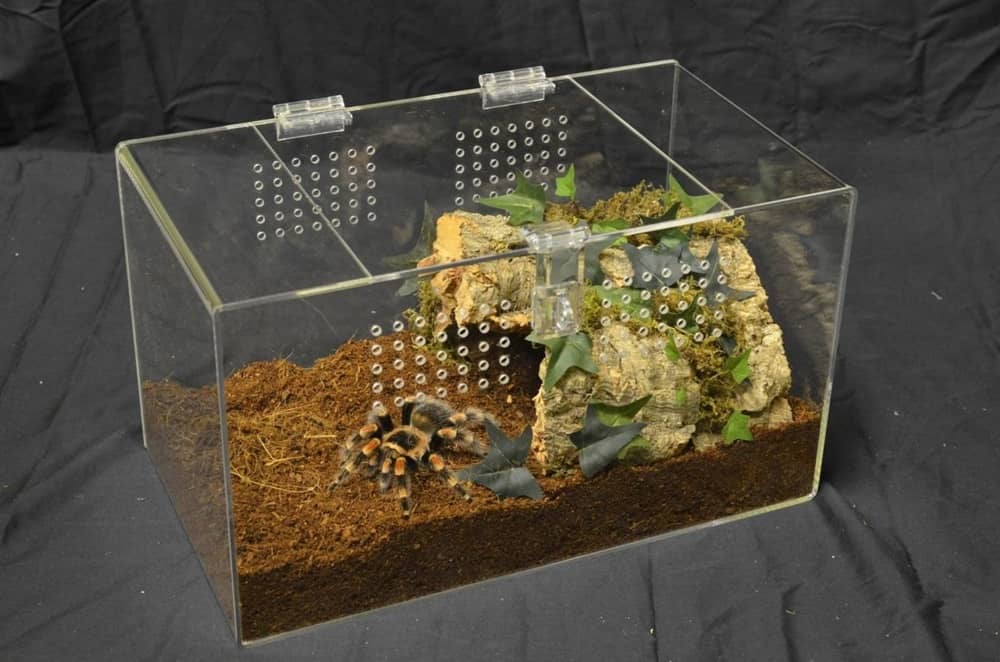
Choosing the Right Tarantula Enclosure
For the species who love to reside in burrows, a low-lying habitat is beneficial and for climbing tarantulas, a vertically oriented cage is preferred. I have tried to include all essential elements for creating the ideal enclosure for your eight-legged friend.
When selecting an enclosure for your tarantula, there are several options available, including glass tanks, plastic/acrylic containers, and specialized tarantula enclosures. You can also try to design an enclosure on your own by following certain guidelines for the same.
The opening mechanism of these cages should be secure and easy to use as it is to be opened frequently for feeding and cleaning. Moreover, it should be well secured so as not to leave any scope for your tarantula to escape!
Tank Size For Your Tarantula
The size of the enclosure depends on the species and size of your tarantula. A general rule of thumb is to provide a habitat that is at least three times the leg span of your tarantula in length and width.
Ensuring the proper enclosure size for your spiderling is crucial for its well-being and survival.
Here’s a breakdown of recommended container sizes based on the size and species of your tarantula:
Terrarium For Spiderlings with a Leg Span of 1/4″ to 1″
The tarantulas can be broadly classified into terrestrial and arboreal on the basis of their likings to burrow or climb trees. The habitat requirements need to be altered accordingly.
Enclosure For Terrestrial Species
Choose a container that is approximately 2″ in diameter and 1.5″ in height. This size provides enough space for the spiderling to move around comfortably without feeling overwhelmed.
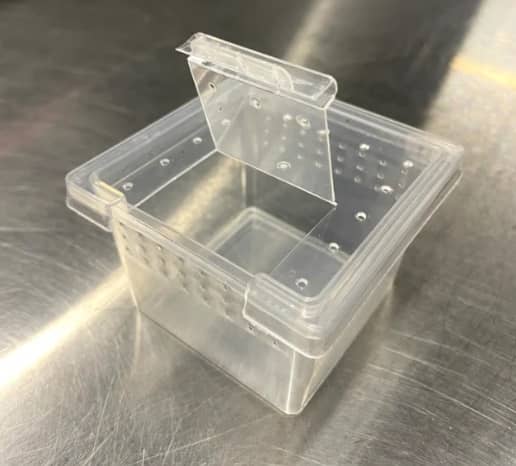
Enclosure For Arboreal Species
You should opt for a container that is 3.5″ tall and 2″ in diameter. Arboreal spiderlings require additional height for climbing and web building activities.
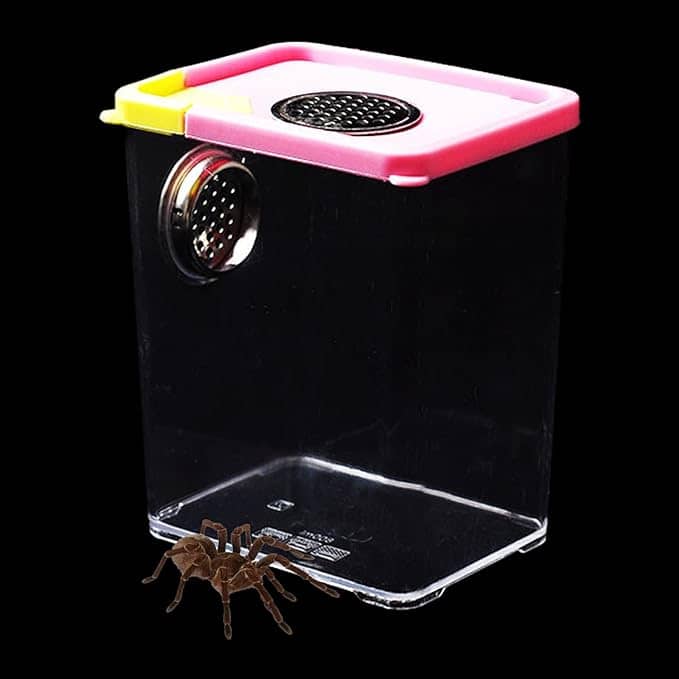
You can also use a Kritter keeper for your spiderlings. These are plastic container with a vented lid to provide enough ventilation for your tarantula. These are low cost containers and are easily available in Wallmart’s fish section or you can take from Amazon as well. The slings enjoy little spacing with ease of burrowing.
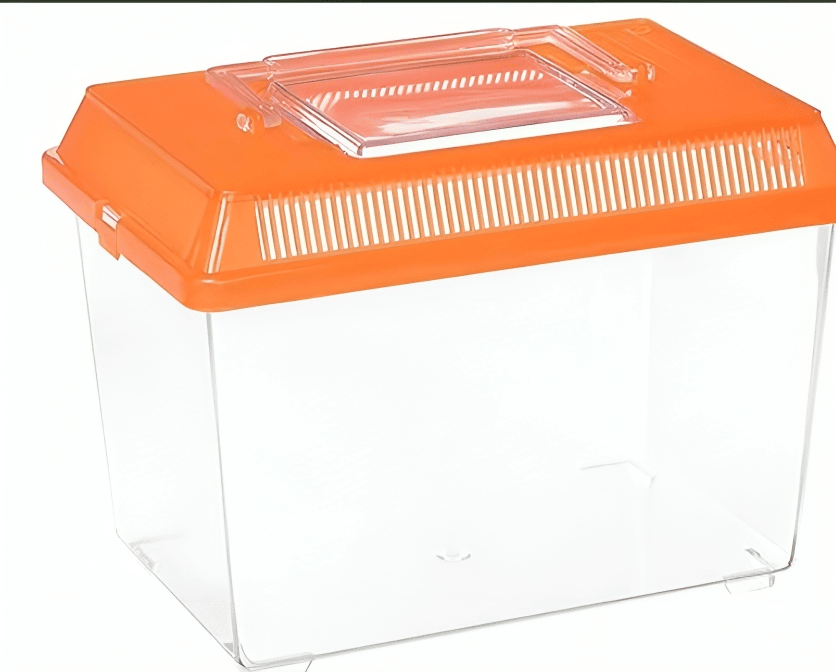
There are some problems which I faced using these. The first one is that there is a hole for running tube through which my tarantula can escape. I fixed this by using hot glue and made it small to prevent any escape.
Another problem was , as there are much more holes, the rate of evaporation is quite high and hence the substrate becomes very dry. I fixed this issue by covering these vents partially with help of plastic wrap. Alternatively , a transparent tape can also serve the purpose.
Enclosure For Spiderlings 1″ or Larger
Enclosure For Terrestrial Species
Select a container that is 4″ in diameter and 2.5″ in height. This size allows ample space for larger spiderlings to move and burrow comfortably.

Enclosure For Arboreal Species
Use a container that is 4″ in diameter and 6″ in height. The extra height accommodates the arboreal species’ natural behaviors, such as climbing and constructing elaborate webs.
By providing an enclosure that matches the size and habitat preferences of your spiderling, you’re setting them up for creating an environment where they can thrive and grow comfortably.
You can then progressively expand your spider’s cage as it molts and gets bigger. It is possible for most species to be moved to a larger home every six months to a year. For some slow-growing tarantulas, you may have to wait a bit longer. Your tarantula is ready for a large cage, a 5 or 10-gallon tank, when it is 3″ or bigger.
Substrate In The Tarantula Enclosure
For optimum growth of your tarantula, substrate plays a crucial role in maintaining humidity levels and providing a comfortable environment that replicates the natural habitat in captivity.
Common substrates include coconut fiber, peat moss, and vermiculite. Ensure that the substrate is deep enough for burrowing species to create tunnels.
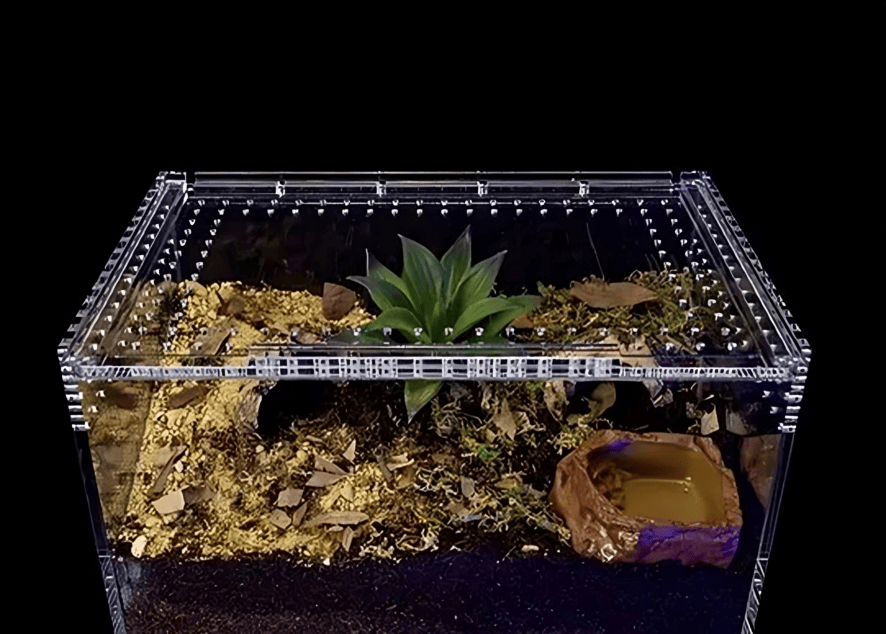
The base of the tarantula cage can be made with coconut mulch, organic soil and ABG mix(A premix bag that contains finely ground tree fern fiber, milled long fiber sphagnum moss, milled sphagnum peat moss, fine charcoal, and fine fir bark.

The bag is made individually guaranteeing the correct ratios. The correct ratio of these substances helps in maintaining the humidity levels as too much humidity can lead to mold and bacteria growth whereas, extremely dry enclosures can lead to dehydration of your tarantula.
Improving Features Of Enrichment
Tarantulas are known for their nocturnal and secretive nature, so it’s essential to provide hiding spots where they can retreat during the day. You can use cork bark, half logs, or artificial plants to create hiding places. Additionally, some species are arboreal and require vertical space for climbing, so consider adding branches or cork tubes for them to explore. Moreover, these decorations greatly enhance the aesthetic sense of the terrarium.
Even though they have a reputation for being solitary and inactive, tarantulas gain from environmental enrichment. Enhancement stimulates their minds, supports their natural habits, and enhances their general wellbeing.
Obstacle courses :Make easy obstacle courses with safe materials, such as soft branches or leaves. By doing this, you may help your tarantula navigate its surroundings and replicate the natural foraging experiences it has.
Hiding and Webbing areas: To mimic their natural shelter and web-building activities, provide a variety of hiding areas and anchor points for web-building.
Environmental Changes: To offer freshness and mental stimulation, periodically rearrange the enclosure’s design by adding new objects or altering the décor.
Rotating Feeding stations: To promote foraging and exploration, provide feeding stations throughout the enclosure in various locations.
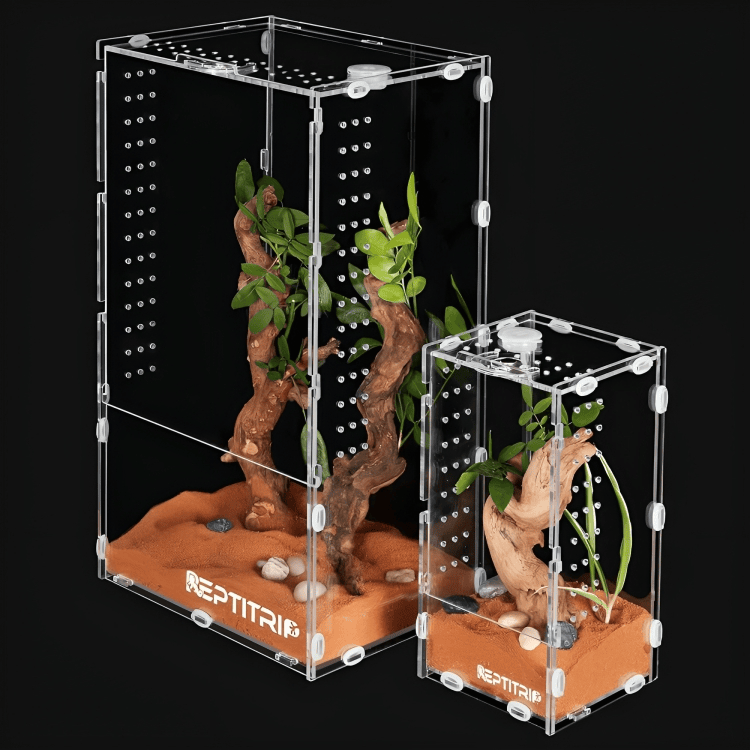
Temperature and Humidity Of Enclosure
Maintaining the appropriate temperature and humidity levels is crucial for the health and well-being of your tarantula. Most tarantulas thrive in temperatures ranging from 70°F to 80°F (21°C to 27°C).
If the temperature drops during nighttime, a heat mat can be used on one side of the glass enclosure. Alternatively, a room heater can be used that regulates the overall temperature of the room where the terrarium of the tarantula is kept.
Humidity requirements vary depending on the species, with some needing higher humidity levels than others. You can maintain humidity by misting the enclosure with water or using a substrate that retains moisture.
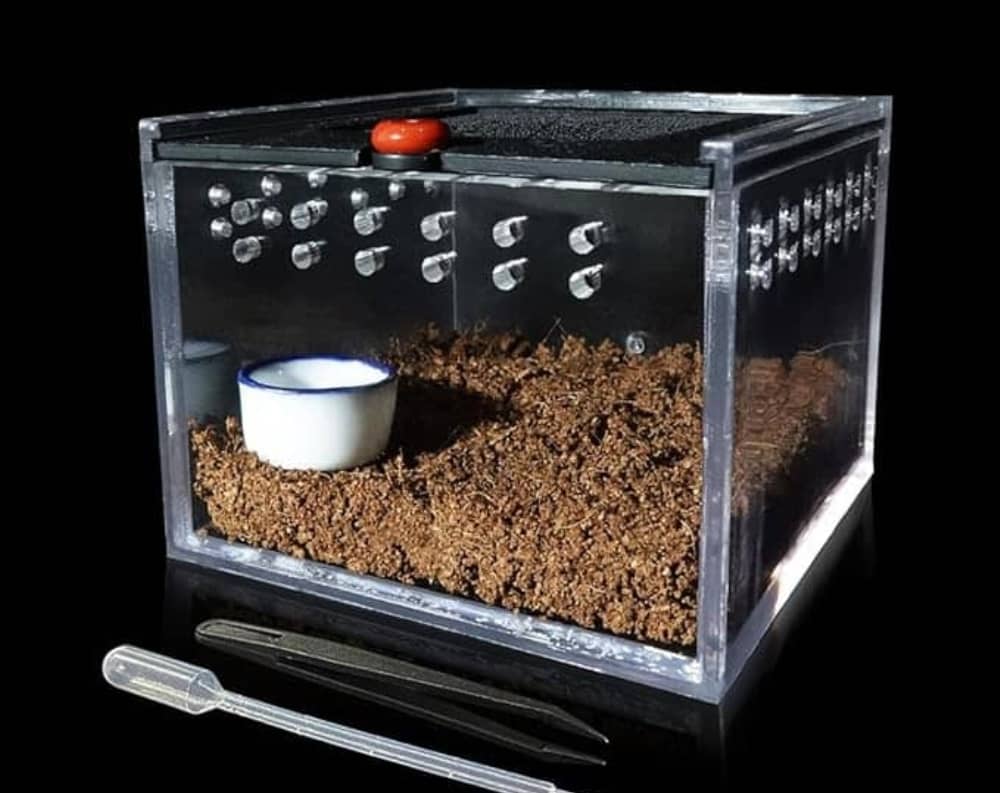
The humidity level in the tarantula crib should be around 65% and should be checked with a humidity gauge. The light color of the substrate is an indication of the dryness and misting with distilled water restores the moisture levels.
Ventilation Of the Habitat
A well-ventilated enclosure is essential to prevent the buildup of moisture and ensure proper air circulation. The stagnant air reduces the air quality of the habitat and thus poses a threat to the well-being of your tarantula.
A well-ventilated habitat prevents mold and bacterial growth, which can be harmful to your tarantula. Many commercially available tarantula enclosures come with ventilation holes, but if you’re using a custom enclosure, make sure to add sufficient ventilation.
Lighting In The Enclosure
While tarantulas do not require UV lighting like some reptiles, providing a natural light cycle can help regulate their behavior. Indirect sunlight or ambient room lighting during the day and darkness at night mimic their natural habitat. I use red light in my tarantula’s room for better viewing in the dark.
Maintenance Of The Enclosure
Regular maintenance of the enclosure is essential for the health of your tarantula. This includes spot cleaning to remove uneaten prey, refreshing the water dish, cleaning the poop, and monitoring temperature and humidity levels. The substrate should be replaced periodically to prevent mold and bacteria buildup.
Safety Precautions Of the Habitat
When setting up the enclosure, it’s crucial to consider safety precautions to prevent escapes and protect both your tarantula and yourself. Ensure all openings are securely closed and escape-proof, especially for terrestrial species that may burrow under loose substrate. Additionally, always wash your hands thoroughly after handling your tarantula or working in the enclosure to prevent the spread of any potential pathogens.
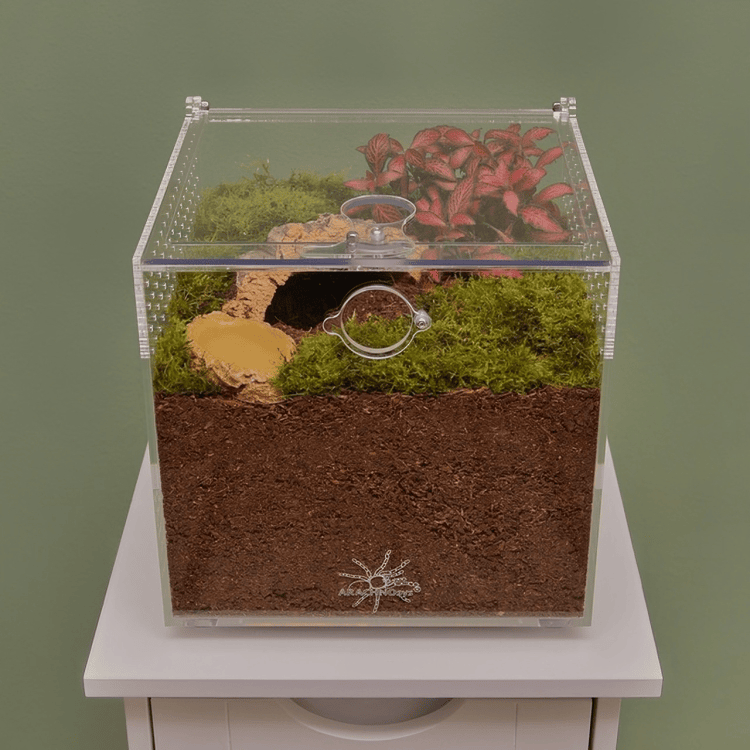
In conclusion, creating the ideal enclosure for your tarantula involves careful consideration of their natural habitat and behavioral needs. By providing appropriate substrate, hiding places, temperature and humidity levels, ventilation, lighting, and regular maintenance, you can create a comfortable and safe environment for your eight-legged friend to thrive in captivity.
Remember to research the specific requirements of your tarantula species to ensure their health and well-being.
Where to buy an Enclosure for your Tarantula?
The enclosure for the tarantula can be purchased online from many websites such as amazon or from some authentic pet stores. You can also try to create your own enclosure as well by meeting the basic necessities for your pet tarantula.
Create Your Own Enclosures (DIY Enclosures)
If you are interested in setting up an enclosure for your eight-legged friend at a low cost, try these methods.
https://www.youtube.com/watch?v=otO1ikmf9vo
Frequently Asked Questions For Setting Up Tarantula Enclosure
- What size enclosure does my tarantula need?
Answer: The size of the enclosure depends on the species and size of your tarantula. As a general rule, provide a habitat that is at least three times the leg span of your tarantula in length and width. You will need to rehouse your tarantula if you start with a sling.
- What all should I consider before purchasing an enclosure for my tarantula?
Answer: There are some of the parameters which I prefer for purchasing, so you can also consider these
- You should first choose an appropriate sized enclosure.
- It should have a well secured system for accessing the terrarium, preferably two way opening cage is more user- friendly . It is easier to feed and clean the enclosure.
- Check for enough space for filling the substrate and accessing the opening door. A space of 5″ or more between the substrate and top increases the chances of fall and injury to your tarantula
- Check for holes to provide cross-ventilation inside the terrarium.
- The substrate mix should include coconut fiber, peat moss, and vermiculite. Choose a substrate that retains moisture well and allows for burrowing, as some species enjoy digging tunnels. Some ready to use pre-mix are available for your convenience.
- How often should I clean my tarantula’s enclosure?
Answer: Spot clean the enclosure regularly to remove uneaten prey and feces. Replace the substrate every few months to prevent mold and bacteria buildup.
- What all does a tarantula need in its enclosure?
Answer: The tarantulas are nocturnal and secretive creatures that require hiding spots to feel secure during the day. Use cork bark, half logs, or artificial plants to create hiding places. Apart from that a water dish and good amount of substrate is also a must for a tarantula.
- What temperature and humidity levels are ideal for my tarantula?
Answer: Most tarantulas thrive in temperatures ranging from 70°F to 80°F (21°C to 27°C). Humidity requirements vary depending on the species, with some needing higher humidity levels than others. Research the specific needs of your tarantula species and adjust the humidity level inside the terrarium accordingly.
- How can I provide proper ventilation in my tarantula’s enclosure?
Answer: The holes inside the enclosure should not be too big or too small. Ensure the enclosure has adequate ventilation holes to allow for proper air circulation. The holes helps prevent mold and bacterial growth. Many commercially available enclosures come with built-in ventilation.
- Can I use artificial lighting in my tarantula’s enclosure?
Answer: Tarantulas do not require UV lighting like some reptiles. However, providing a natural light cycle with ambient room lighting during the day and darkness at night can help regulate their behavior. You can use a red light in the room of tarantula for viewing in the dark.
- What precautions should I take while feeding my tarantula?
Answer: You should serve the feed to your tarantula with the help of tweezers. If you are serving live prey then you should try to drop it near your tarantula to reduce any kind of stress for your tarantula. Secure the lid after giving the feed. You should serve pre-killed crickets, moths or mealworms to spiderlings.
Moreover, a shallow water dish should be provided to ensure your tarantula has access to clean water. Make sure the dish is small enough to prevent drowning accidents but large enough for your tarantula to get moisture from. The tarantulas get the required moisture through evaporation of water from this water dish. You should clean the water dish at regular intervals.
Moreover, while placing the water dish you should ensure that it is away from the edges. This will prevent the tarantula hurting itself from the edges of water dish, if it accidently falls.
9. Where should I place the terrarium in my house?
Answer: You should place the enclosure of your tarantula in a secluded dark corner of your home which is free from noises. It will help tarantula to thrive in a comfortable environment.
10. How can I prevent my tarantula from escaping its enclosure?
Answer: Ensure all openings are securely closed and escape-proof, especially for terrestrial species that may burrow under loose substrate. Regularly check for any gaps or cracks in the enclosure and take necessary precautions to prevent escapes. Under the condition of escape , you can bribe your tarantula with some moist towels or a water dish. You can use catch cups to gently pick your tarantula without stressing it.


